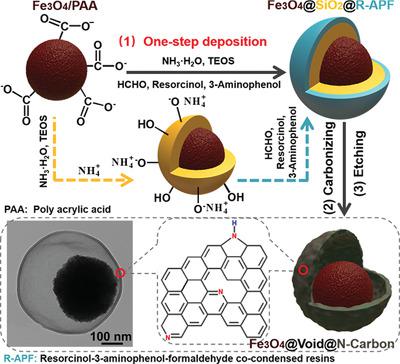当前位置:
X-MOL 学术
›
Macromol. Rapid Commun.
›
论文详情
Our official English website, www.x-mol.net, welcomes your
feedback! (Note: you will need to create a separate account there.)
Yolk-Shell Fe3 O4 @Void@N-Carbon Nanostructures Based on One-Step Deposition of SiO2 and Resorcinol-3-Aminophenol-Formaldehyde (R-APF) Cocondensed Resin Dual Layers onto Fe3 O4 Nanoclusters.
Macromolecular Rapid Communications ( IF 4.2 ) Pub Date : 2020-08-07 , DOI: 10.1002/marc.202000307 Kesong Tian 1 , Junyan Wang 1 , Wanchun Guo 1 , Ruifei Li 1 , Ling Cao 1 , Zhaopeng Xu 2 , Haiyan Wang 1
Macromolecular Rapid Communications ( IF 4.2 ) Pub Date : 2020-08-07 , DOI: 10.1002/marc.202000307 Kesong Tian 1 , Junyan Wang 1 , Wanchun Guo 1 , Ruifei Li 1 , Ling Cao 1 , Zhaopeng Xu 2 , Haiyan Wang 1
Affiliation

|
Yolk–shell magnetic nanoparticles@nitrogen‐enriched Carbon nanostructures with a magnetic core and a hollow nitrogen‐enriched carbon shell exhibit considerable promise in various applications, such as drug delivery, heterogenous catalysts, removal of metal ions and organic pollutants, and screening of biomolecules, due to their strong magnetic response, unique cavities, and the selective absorption ability of nitrogen‐enriched groups. However, their complicated synthesis always involves possible surface modification, layer‐by‐layer deposition of a sacrificial middle layer and an outer nitrogen‐enriched layer on magnetic nanoparticles, subsequent carbonization, and final removal of the sacrificial middle layer. Herein, yolk–shell Fe3O4@nitrogen‐enriched carbon nanostructures are constructed based on NH4+ ion‐induced one‐step deposition of SiO2 and Resorcinol‐3‐aminophenol‐formaldehyde cocondensed resin (R‐APF) dual layers onto poly acrylic acid‐modified Fe3O4 nanoclusters without any extra surface modification. The N‐Carbon shell thickness of the yolk–shell Fe3O4@Void@N‐Carbon nanostructure can be finely tailored though tailoring the feeding amount of aminophenol and resorcinol to tune the thickness of the outer R‐APF resin shell onto Fe3O4@SiO2 intermediate particles. This NH4+ ion‐induced one‐pot deposition of double layers can effectively promote synthesis efficiency of this kind of yolk–shell nanostructure.
中文翻译:

基于SiO2和间苯二酚-3-氨基酚-甲醛(R-APF)共缩树脂双层一步沉积到Fe3 O4纳米簇上的卵黄壳Fe3 O4 @空@N碳纳米结构。
卵黄壳磁性纳米颗粒@富氮的碳纳米结构,具有磁芯和中空富氮的碳壳,在各种应用中都显示出巨大的希望,例如药物输送,非均相催化剂,金属离子和有机污染物的去除以及生物分子的筛选,由于其强大的磁响应,独特的空腔以及富氮基团的选择性吸收能力。然而,它们复杂的合成过程总是涉及可能的表面改性,在磁性纳米颗粒上逐层沉积牺牲中间层和外部富氮层,随后的碳化以及最终去除牺牲中间层。在此,蛋黄壳Fe 3 O 4@富含氮的碳纳米结构是基于NH 4 +离子诱导的SiO 2和间苯二酚-3-氨基苯酚-甲醛共聚树脂(R-APF)双层一步沉积到聚丙烯酸改性的Fe 3 O 4上而构建的无需任何额外表面修饰的纳米簇。可以通过定制氨基酚和间苯二酚的进料量来调整蛋黄壳Fe 3 O 4 @ Void @ N-Carbon纳米结构的N-碳壳厚度,以调整外部R-APF树脂壳在Fe 3上的厚度。O 4 @SiO 2中间颗粒。NH 4 + 离子诱导的双层单锅沉积可以有效地提高这种蛋黄壳纳米结构的合成效率。
更新日期:2020-09-08
中文翻译:

基于SiO2和间苯二酚-3-氨基酚-甲醛(R-APF)共缩树脂双层一步沉积到Fe3 O4纳米簇上的卵黄壳Fe3 O4 @空@N碳纳米结构。
卵黄壳磁性纳米颗粒@富氮的碳纳米结构,具有磁芯和中空富氮的碳壳,在各种应用中都显示出巨大的希望,例如药物输送,非均相催化剂,金属离子和有机污染物的去除以及生物分子的筛选,由于其强大的磁响应,独特的空腔以及富氮基团的选择性吸收能力。然而,它们复杂的合成过程总是涉及可能的表面改性,在磁性纳米颗粒上逐层沉积牺牲中间层和外部富氮层,随后的碳化以及最终去除牺牲中间层。在此,蛋黄壳Fe 3 O 4@富含氮的碳纳米结构是基于NH 4 +离子诱导的SiO 2和间苯二酚-3-氨基苯酚-甲醛共聚树脂(R-APF)双层一步沉积到聚丙烯酸改性的Fe 3 O 4上而构建的无需任何额外表面修饰的纳米簇。可以通过定制氨基酚和间苯二酚的进料量来调整蛋黄壳Fe 3 O 4 @ Void @ N-Carbon纳米结构的N-碳壳厚度,以调整外部R-APF树脂壳在Fe 3上的厚度。O 4 @SiO 2中间颗粒。NH 4 + 离子诱导的双层单锅沉积可以有效地提高这种蛋黄壳纳米结构的合成效率。











































 京公网安备 11010802027423号
京公网安备 11010802027423号